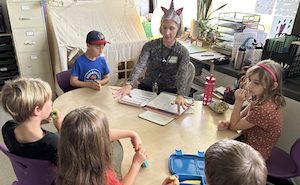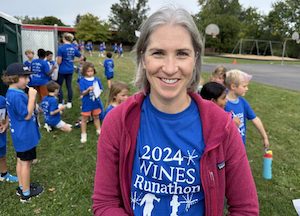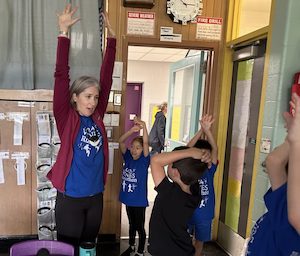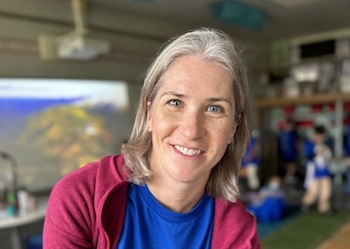By Jo Mathis / AAPS News Editor
Anna Milanowski was born in west Michigan and eventually made it to the University of Michigan for her undergraduate degree. She began teaching in Chicago in a dual language, Spanish-English school while earning her master’s degree in Elementary Education from Northwestern University. Later, after a few years of teaching in Detroit’s Mexicantown, Milanowski made her way back to Ann Arbor to teach at Wines Elementary.
Milanowski and her family are residents of the Wines neighborhood and she says she’s happy to have so many of her former students as neighbors.
She is currently pursuing a second master’s degree with the WMU Grow Your Own TESOL program. In her free time, Milanowski enjoys running and preparing for the next road race, traveling to new countries, and doing arts and crafts with her five-year-old daughter.
Principal David DeYoung said Milanowski is a fantastic second grade teacher who works very hard to meet the needs of all students and that Wines is a better school and AAPS a better district because of teachers like her.
“Anna Milanowski is the type of teacher that every school and every student loves to have,” he said. “Anna is warm, kind, intelligent, and extremely hardworking. She plans for the success of each individual student and is consistently self-reflective to ensure she is always meeting the needs of every student in her classroom.”
DeYoung says that as one who is always learning, Milanowski is a district leader in implementing new approaches to literacy acquisition.
“Anna regularly opens her classroom to teachers at Wines and across our district for ‘learning walks’ to support the professional growth of our colleagues,” he said. “Anna always remains positive in the face of any challenge and is someone that every child knows will be consistent, fair, and loving.”
What inspired you to become a second grade teacher?
I remember as a second grader wanted to become a social worker like Jane Addams when I grew up, so from an early age I wanted a career in service of others. Later, as an undergrad at U-M, I served as an America Reads tutor in Detroit for four years. We would travel to Detroit each week and be paired with a few students to work on literacy skills. One week I went to pick up my kiddo and found him standing face-first in the corner as a form of discipline. That heartbreaking moment was when I decided I wanted to try teaching. I was hoping I might have a more compassionate response.

What strategies do you use to engage students with different learning styles?
Well, I’d quibble with the idea of teaching to different learning styles. Learners don’t necessarily have a particular learning style per se, but effective instruction and retention of knowledge can come from learning in a variety of ways, over time. Thus, in our classroom, you might hear us singing a song about doubles facts, making artistic posters about the Turn Around Rule, using manipulatives, playing games related to our content goals, or working in small groups.
Additionally, I try to weave in student experience and interest into our learning to increase engagement. We write number stories about classmates’ Pokémon cards or write an opinion piece about our favorite graphic novel.
Do you have any tips for classroom management?
At the beginning of my career, I really struggled with classroom management. I thought I had to be mean and raise my voice to lead a class. I know now I am better able to build relationships with kids and this is a sturdy leader that my class listens to and wants to hear from when I am vulnerable and fully myself. I let kids know about my life, the things and people I love, and how I’m feeling. I share stories about emotions I’ve had that people don’t often talk about—like when I’ve felt embarrassed, worried, and shamed. I show myself making mistakes and being kind to myself through those mistakes. This honesty encourages kids to also share about themselves and bond us, which of course turns classroom management.
I’d be remiss if I didn’t mention planning and structure. Our classroom runs smoothly when kids know the routine and how to execute class routines successfully. Thus, we spend a lot of time learning and practicing the basics of moving through our room. Additionally, lesson planning is such a crucial piece of classroom management. I think a lot about the pacing of a lesson, the practice opportunities I give students, and making content relevant to my kids.

What do you like about working at Wines?
One of the reasons I enjoy teaching at Wines—and a reason I hope my students also enjoy being at school—is that I can be myself. Wines is a place where it’s welcomed to be warm and caring towards students. If you look down the hallway as the bell rings, you’ll see teachers giving high fives and hugs with big smiles as students enter their classrooms. That care and outward kindness fills me up and is contagious. At Wines, I’m given the freedom and encouragement to pursue professional development that is meaningful to me. This has helped increase my confidence as a teacher and feel more grounded in best practices.
What’s the most challenging aspect of ensuring every student’s needs are met?
A challenging reality we’re facing in terms of meeting the needs of each student in AAPS is staffing. Teacher assistants, social workers, and special education teachers—to name a few—are such vital parts of giving students the academic, behavioral, and emotional support they need. We must increase pay and support for these positions so we can attract great candidates and provide these vital services to our most vulnerable.
What professional development activities have you found most helpful in your career?
Responsive classroom training has been quite impactful on my day-to-day habits. The elements of morning meetings, energizers, a rest and return area, and classroom rules that are thoughtfully created by the students themselves have led to more joy throughout the day, but also spaces for students to feel their feelings. Additionally, LETRS training has helped me shift my literacy practice to more research-based components. Finally, the TESOL Grow Your Own courses have really reinvigorated my passion for multilingualism and given me more tools to welcome different languages and cultures into our classroom.

What message would you send to your 10-year-old self?
As a young person I struggled to read and despite my best efforts, didn’t really understand school or how to be good at it. I’d tell myself: keep working, keep letting people know when you don’t understand. Beyond innate intelligence, hard work, seeking out help, and determination are paths to success.
What are you excited about these days?
There is a lot of good to focus on these days. I have a lovely class this year that’s thoughtful, funny and just generally good to be with. Additionally, our daughter has started Young Fives at the school I teach. Seeing her develop in this next chapter of life is an ongoing joy. Finally, I’m gearing up to run the Detroit Half Marathon with a dear friend.









